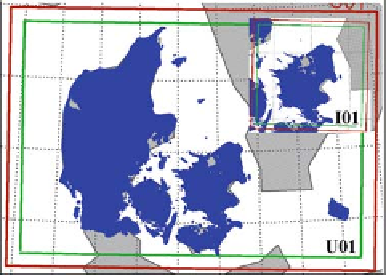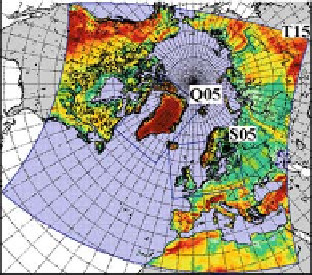Environmental Engineering Reference
In-Depth Information
variability have shown that, in general, these have magnitudes and diurnal behaviour
similar to rural areas, but within the city itself there are differences between districts
of the city.
The goal of our study is to evaluate effects of urbanization of a numerical weather
prediction (NWP) model on simulating meteorological fields for specific cases and
overall model performance over the urbanized areas. The specific objectives include:
(1) perform short- and long-term simulations of meteorological fields using NWP
model in two modes: control vs. urbanized runs; (2) evaluate effects of urbanization
on temporal-spatial structure and variability of simulated meteorological fields; and
(3) estimate the diurnal cycle and the differences between control and urbanized runs
for meteorological variables such as air temperature, wind, and relative humidity.
14.2 Methodology
14.2.1 DMI-HIRLAM NWP Modelling and Meteorological Data
The DMI performs daily forecasts of meteorological fields employing the High Res-
olution Limited Area Model (HIRLAM) model (Unden et al., 2002). The present
DMI weather forecasting system (Yang et al., 2005) is based on HIRLAM 7. Since
summer of 2004, it consists of two nested models: DMI-HIRLAM-T15 and -S05
(Fig. 14.1a) as well as running also on specific testing and research domains (such
-Q05, -L15, -M15 - not shown) covering different regions of the Northern Hemi-
sphere. Previously several nested DMI-HIRLAM models called -G, -N, -E, and -D
were run operationally with horizontal resolutions of 0.45, 0.15, 0.15, and 0.05º,
respectively (Sass et al., 2002).
The models T15 and S05 are identical, except for the horizontal resolution (15
vs. 5 km) and geographical boundaries of domains. Both versions have 40 verti-
(a)
(b)
Fig. 14.1
DMI-HIRLAM-NWP modelling domains
(a)
operational -T15 and -S05 and
(b)
research -U01 and -I01


Search WWH ::

Custom Search